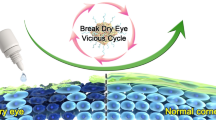Abstract
The purpose of this research was to optimize the formulation factors for maximum in vitro permeation of gatifloxacin from aqueous drops through excised goat cornea and to evaluate the permeation characteristics of drug from selected marketed eyedrop formulations. Permeation studies were conducted by putting 1 mL of formulation on the cornea (0.67 cm2) fixed between the donor and receptor compartments of an all-glass modified Franz diffusion cell and measuring gatifloxacin concentration in the receptor (containing normal saline under stirring) by spectrophotometry at 291.5 nm, after 120 minutes. Raising the drug concentration of the drops increased the drug permeation but decreased the percent permeation and the in vitro ocular availability. Raising the pH of the formulation from pH 5 to 7.2 increased both the drug permeation and the in vitro ocular availability. Eyedrops containing benzalkonium chloride (BAK; 0.01% wt/vol) and disodium edetate (EDTA; 0.01% wt/vol) showed maximum permeation, followed by Zymar, BAK (0.01% wt/vol), Gatilox, Gatiquin, and Gate (statistically significantP<.05 compared with control). In vitro titration of the formulations with 0.1N NaOH indicated the presence of a buffer in Zymar (pH 6) and Gate (pH 5.8), which may cause irritation and induce lacrimation, resulting in reduced ocular availability in vivo. Thus, formulation with BAK and EDTA, which is unbuffered, has a better likelihood of being absorbed in vivo. The BAK-EDTA formulation significantly (P<.05) increased the permeation of gatifloxacin through paired excised corneas of goat, sheep, and buffalo, compared with the control formulation. The goat cornea showed the greatest increase in permeation, followed by the sheep and buffalo corneas.
Similar content being viewed by others
References
Hardman JG, Limbird LE, eds.Goodman and Gilman’s The Pharmacological Basis of Therapeutics. 10th ed. New York, NY: McGraw Hill; 2001.
Leeming JP. Treatment of ocular infections with topical antibacterials.Clin Pharmacokinet. 1999;37:351–360.
Abshire R, Cockrum P, Crider J, Schlech B. Topical antibacterial therapy for mycobacterial keratitis: potential for surgical prophylaxis and treatment.Clin Ther. 2004;26:191–196.
Adenis JP, Colin J, Verin P, Saint-Blancat P, Malet F. Ciprofloxacin ophthalmic solution versus rifamycin ophthalmic solution for the treatment of conjunctivitis and blepharitis.Eur J Ophthalmol. 1995;5:82–87.
Diamond JP, White L, Leeming JP, Bing Hoh H, Easty DL. Topical 0.3% ciprofloxacin, norfloxacin, and ofloxacin in treatment of bacterial keratitis: a new method for comparative evaluation of ocular drug penetration.Br J Ophthalmol. 1995;79:606–609.
Grosset J. Norfloxacin: a broad-spectrum quinolone for superficial eye infections.Pathol Biol (Paris). 1990;38:735–741.
Gross RD, Hoffman RO, Lindsay RN. A comparison of ciprofloxacin and tobramycin in bacterial conjunctivitis in children.Clin Pediatr (Phila). 1997;36:435–444.
Jauch A, Fsadni M, Gamba G. Meta-analysis of six clinical phase III studies comparing lomefloxacin 0.3% eye drops twice daily to five standard antibiotics in patients with acute bacterial conjunctivitis.Graefes Arch Clin Exp Ophthalmol. 1999;237:705–713.
Cochereau-Massin I, Bauchet J, Marrakchi-Benjaafar S, et al. Efficacy and ocular penetration of sparfloxacin in experimental streptococcal endophthalmitis.Antimicrob Agents Chemother. 1993;37:633–636.
Perry CM, Barman Balfour JA, Lamb HM. Gatifloxacin.Drugs. 1999;58:683–696.
Chaudhry NA Jr, Flynn HW Jr, Murray TG Jr, Tabandeh H Jr, Mello MO Jr, Miller D. Emerging ciprofloxacin resistant.Pseudomonas aeruginosa. Am J Ophthalmol. 1999;128:509–510.
Garg P, Sharma S, Rao GN. Ciprofloxacin resistant Pseudomonas keratitis.Ophthalmology. 1999;106:1319–1323.
Perry CM, Ormrod D, Hust M, Susan VO. Gatifloxacin: a review of its use in the management of bacterial infections.Drugs. 2002;62: 169–207
Jensen H, Zerouala C, Carrier M, Short B. Comparison of ophthalmic gatifloxacin 0.3% and ciprofloxacin 0.3% in healing of corneal ulcers associated with Pseudomonas aeruginosa-induced ulcerative keratitis in rabbits.J Ocul Pharmacol Ther. 2005;21: 36–43.
Kaliamurthy J, Nelson Jesudasan CA, Geraldine P, Parmar P, Kalavathy CM, Thomas PA. Comparison of in vitro susceptibilities of ocular bacterial isolates to gatifloxacin and other topical antibiotics.Ophthalmic Res. 2005;37:117–122.
Yee RW, Tepedino M, Bernstein P, Jensen H, Schiffman R, Whitcup SMGatifloxacin BID/QID Study Group. A randomized, investigatormasked clinical trial comparing the efficacy and safety of gatifloxacin 0.3% administered BID versus QID for the treatment BID versus QID for the treatment of acute bacterial conjunctivitis of acute bacterial conjunctivitis.Curr Med Res Opin. 2005;21:425–431.
Ross DL, Riley CM. Aqueous solubilities of some variously substituted quinolone antimicrobials.Int J Pharm. 1990;63:237–250.
Hecht G, Roehrs RE, Cooper ER, Hiddemen JW, Van Duzee BF. Design and evaluation of ophthalmic pharmaceutical products. In: Banker GS, Rhodes CT, eds.Modern Pharmaceutics. vol. 40. 2nd ed. New York, NY: Marcel Dekker; 1990:539–603.
Malhotra M, Majumdar DK. In vitro transcorneal permeation of ketorolac tromethamine from buffered and unbuffered aqueous ocular drops.Indian J Exp Biol. 1997;35:941–947.
Gupta M, Majumdar DK. Effect of concentration, pH and preservative on in vitro transcorneal permeation of ibuprofen and flurbiprofen from non-buffered aqueous drops.Indian J Exp Biol. 1997;35:844–849.
Richman JB, Tang-Liu DD. A corneal perfusion device for estimating ocular bioavailability in vitro.J Pharm Sci. 1990;79: 153–157.
Pawar PK, Majumdar DK. Effect of formulation factors on in vitro permeation of moxifloxacin from aqueous drops through excised goat, sheep, and buffalo corneas.AAPS PharmSciTech. 2006;7:E13.
Maurice DM, Riley MV.Ocular pharmacokinetics. In: Graymore CN, ed.Biochemistry of the Eye. London, UK: Academic Press; 1970: 6–16.
Bristol Myers Squibb Company. New Drug Application for Tequin (Gatifloxacin Tablets and Injections). Environmental Assessment.Center for Drug Evaluation and Research Website. 2001. Accessed: May 31, 2006.
Fu RC, Lidgate DM. In vitro rabbit corneal permeability study of ketorolac tromethamine.Drug Dev Ind Pharm. 1986;12:2403–2430.
Gibaldi M.Biopharmaceutics and Clinical Pharmacokinetics. Philadelphia, PA: Lea & Febiger; 1984.
Ahmed I, Patton TF: Effect of pH and buffer on the precorneal disposition and ocular penetration of pilocarpine in rabbits.Int J Pharm. 1984;19:215–227.
Ahmed I, Chaudhuri B. Evaluation of buffer system in ophthalmic product development.Int J Pharm. 1988;44:97–105.
Author information
Authors and Affiliations
Corresponding author
Additional information
Published: July 7, 2006
Rights and permissions
About this article
Cite this article
Rathore, M.S., Majumdar, D.K. Effect of formulation factors on in vitro transcorneal permeation of gatifloxacin from aqueous drops. AAPS PharmSciTech 7, 57 (2006). https://doi.org/10.1208/pt070357
Received:
Accepted:
Published:
DOI: https://doi.org/10.1208/pt070357




